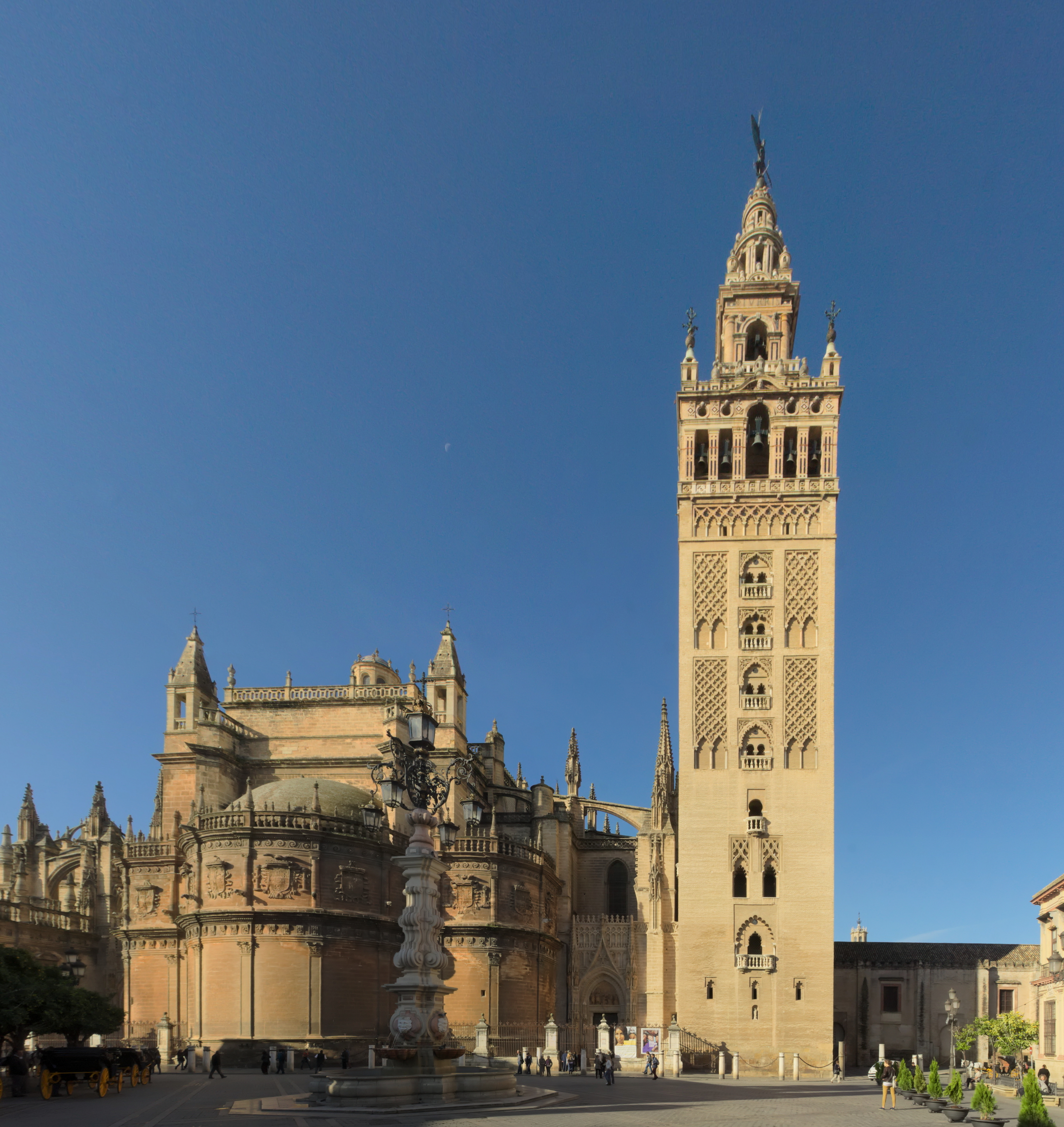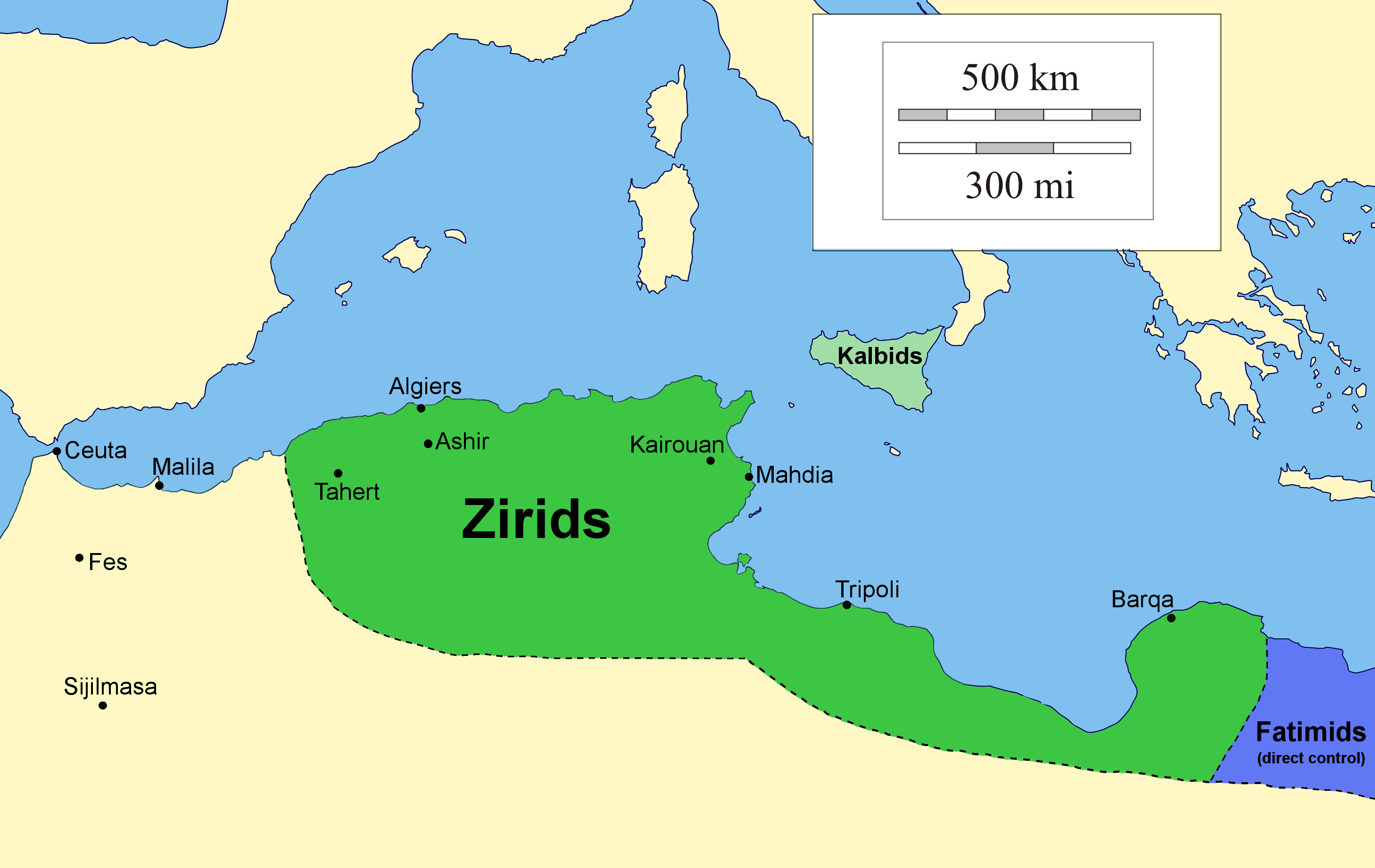|
Al Qal'a Of Beni Hammad
Qal'at Bani Hammad (), also known as Qal'a Bani Hammad or Qal'at of the Beni Hammad (among other variants), is a fortified palatine city in Algeria. Now in ruins, in the 11th century, it served as the first capital of the Hammadid dynasty. It is in the Hodna Mountains northeast of M'Sila, at an elevation of , and receives abundant water from the surrounding mountains. The site is near the town of Maadid (aka Maadhid), about southeast of Algiers, in the Maghreb. In 1980, it was inscribed as a World Heritage Site by UNESCO under the name Al Qal'a of Beni Hammad, and described as "an authentic picture of a fortified Muslim city". The town includes a long line of walls. Inside the walls are four residential complexes, and the largest mosque built in Algeria after that of Mansurah. It is similar in design to the Grand Mosque of Kairouan, with a tall minaret, . Excavations have brought to light numerous terracotta, jewels, coins and ceramics testifying to the high level of civiliz ... [...More Info...] [...Related Items...] OR: [Wikipedia] [Google] [Baidu] |
Grand Mosque Of Kairouan
The Great Mosque of Kairouan (), also known as the Mosque of Uqba (), is a mosque situated in the World Heritage Site, UNESCO World Heritage town of Kairouan, Tunisia and is one of the largest Islamic monuments in North Africa. Established by the Arab general Uqba ibn Nafi in the year 50 Islamic calendar , AH (670 C.E.) at the founding of the city of Kairouan, the mosque occupies an area of over . It is one of the oldest places of worship in the Muslim world, Islamic world, and is a model for all later mosques in the Maghreb.''Great Mosque of Kairouan'' (discoverislamicart.org) Its perimeter, of about , contains a hypostyle prayer hall, a marble-paved courtyard and a square minaret. In addition to its spiritual prestige, the Mosque of Uqba is on ... [...More Info...] [...Related Items...] OR: [Wikipedia] [Google] [Baidu] |
Minaret
A minaret is a type of tower typically built into or adjacent to mosques. Minarets are generally used to project the Muslim call to prayer (''adhan'') from a muezzin, but they also served as landmarks and symbols of Islam's presence. They can have a variety of forms, from thick, squat towers to soaring, pencil-thin spires. Etymology Two Arabic words are used to denote the minaret tower: ''manāra'' and ''manār''. The English word "minaret" originates from the former, via the Turkish language, Turkish version (). The Arabic word ''manāra'' (plural: ''manārāt'') originally meant a "lamp stand", a cognate of Hebrew language, Hebrew ''Temple menorah, menorah''. It is assumed to be a derivation of an older Linguistic reconstruction, reconstructed form, ''manwara''. The other word, ''manār'' (plural: ''manā'ir'' or ''manāyir''), means "a place of light". Both words derive from the Arabic root ''n-w-r'', which has a meaning related to "light". Both words also had other meani ... [...More Info...] [...Related Items...] OR: [Wikipedia] [Google] [Baidu] |
Great Mosque Of Qal'at Bani Hammad
The Great Mosque of Al Qala'a() is a major historical Mosque located in the UNESCO World Heritage city of Qal'at Bani Hammad, in the province of M'sila, Algeria. Its construction dates back to the early 11th century, during the rule of the Hammadid Emir Hammad ibn Buluggin. The Mosque spans an area of over 3500 square meters (38,000 sq ft), taking on a rectangular layout. It encompasses a vast courtyard, a hypostyle prayer hall, and a square minaret towering at 25 meters (82 ft) in height. Regarded as one of the largest historic mosques in Algeria, second only to the Mansourah, it also contains one of the country's oldest minarets. Additionally, the mosque likely exerted an influence on subsequent Almohad minarets, notably the Giralda in Seville. Together with other archaeological remnants of palatial structures, it stands as a primary testament to the opulence and impact of the Hammadid civilization. History The mosque was founded by the first Hammadid emir, Hammad i ... [...More Info...] [...Related Items...] OR: [Wikipedia] [Google] [Baidu] |
Keep
A keep is a type of fortified tower built within castles during the Middle Ages by European nobility. Scholars have debated the scope of the word ''keep'', but usually consider it to refer to large towers in castles that were fortified residences, used as a refuge of last resort should the rest of the castle fall to an adversary. The first keeps were made of timber and formed a key part of the motte-and-bailey castles that emerged in Normandy and Anjou during the 10th century; the design spread to England, Portugal, south Italy and Sicily. As a result of the Norman Conquest of England in 1066, use spread into Wales during the second half of the 11th century and into Ireland in the 1170s. The Anglo-Normans and French rulers began to build stone keeps during the 10th and 11th centuries, including Norman keeps, with a square or rectangular design, and circular shell keeps. Stone keeps carried considerable political as well as military importance and could take a decade or more t ... [...More Info...] [...Related Items...] OR: [Wikipedia] [Google] [Baidu] |
Palace
A palace is a large residence, often serving as a royal residence or the home for a head of state or another high-ranking dignitary, such as a bishop or archbishop. The word is derived from the Latin name palātium, for Palatine Hill in Rome which housed the Roman Empire, Imperial residences. Most European languages have a version of the term (''palats'', ''palais'', ''palazzo'', ''palacio'', etc.) and many use it to describe a broader range of buildings than English. In many parts of Europe, the equivalent term is also applied to large private houses in cities, especially of the aristocracy. It is also used for some large official buildings that have never had a residential function; for example in French-speaking countries ''Palais de Justice'' is the usual name of important courthouses. Many historic palaces such as parliaments, museums, hotels, or office buildings are now put to other uses. The word is also sometimes used to describe an elaborate building used for public ent ... [...More Info...] [...Related Items...] OR: [Wikipedia] [Google] [Baidu] |
Emir
Emir (; ' (), also Romanization of Arabic, transliterated as amir, is a word of Arabic language, Arabic origin that can refer to a male monarch, aristocratic, aristocrat, holder of high-ranking military or political office, or other person possessing actual or ceremonial authority. The title has a history of use in West Asia, East Africa, West Africa, Central Asia, and South Asia. In the modern era, when used as a formal monarchical title, it is roughly synonymous with "prince", applicable both to a son of a hereditary monarch, and to a reigning monarch of a sovereign principality, namely an emirate. The female, feminine form is emira ( '), with the same meaning as "princess". Prior to its use as a monarchical title, the term "emir" was historically used to denote a "commander", "general", or "leader" (for example, Amir al-Mu'min). In contemporary usage, "emir" is also sometimes used as either an honorary or formal title for the head of an Islamic, or Arab (regardless of relig ... [...More Info...] [...Related Items...] OR: [Wikipedia] [Google] [Baidu] |
Maquette De Kalaa De Beni Hammad
A ''maquette'' is a scale model or rough draft of an unfinished sculpture or work of architecture. The term is a loanword from French. An equivalent term is ''bozzetto'', a diminutive of the Italian word for a sketch. Sculpture A maquette is used to visualize and test forms and ideas without incurring the expense and effort of producing a full-scale piece. It is the analogue of the Painting, painter's Cartoon#Fine art, cartoon, ''modello'', oil sketch, or Sketch (drawing), drawn sketch. For commissioned works, especially monumental public sculptures, a maquette may be used to show the client how the finished work will relate to its proposed site. The term may also refer to a prototype for a video game, film, or other media. ''Modello'', unlike the other terms, is also used for sketches for two-dimensional works such as paintings. Like oil sketches, these models by highly regarded artists can become as desirable as their completed works, as they show the process of developing ... [...More Info...] [...Related Items...] OR: [Wikipedia] [Google] [Baidu] |
Almohads
The Almohad Caliphate (; or or from ) or Almohad Empire was a North African Berber Muslim empire founded in the 12th century. At its height, it controlled much of the Iberian Peninsula (Al-Andalus) and North Africa (the Maghreb). The Almohad movement was founded by Ibn Tumart among the Berber Masmuda tribes, but the Almohad caliphate and its ruling dynasty, known as the Mu'minid dynasty, were founded after his death by Abd al-Mu'min. * Around 1121, Ibn Tumart was recognized by his followers as the Mahdi, and shortly afterwards he established his base at Tinmel in the Atlas Mountains. Under Abd al-Mu'min (r. 1130–1163), they succeeded in overthrowing the ruling Almoravid dynasty governing the western Maghreb in 1147, when he conquered Marrakesh and declared himself caliph. They then extended their power over all of the Maghreb by 1159. Al-Andalus followed, and all of Muslim Iberia was under Almohad rule by 1172. The turning point of their presence in the Iberian Peninsula ... [...More Info...] [...Related Items...] OR: [Wikipedia] [Google] [Baidu] |
Banu Hilal
The Banu Hilal () was a confederation of Arab tribes from the Najd region of the central Arabian Peninsula that emigrated to the Maghreb region of North Africa in the 11th century. They ruled the Najd, and campaigned in the borderlands between Iraq and Syria. When the Fatimid Caliphate became the rulers of Egypt and the founders of Cairo in 969, they confined the Bedouin in the south before sending them to Central North Africa (Libya, Tunisia and Algeria) and then to Morocco. Historians estimate the total number of Arab nomads who migrated to the Maghreb in the 11th century to be to 500,000 to 700,000 to 1,000,000. Historian Mármol Carvajal estimated that more than a million Hilalians migrated to the Maghreb between 1051 and 1110, and estimated that the Hilalian population in the Maghreb at his time in 1573 was at 4,000,000 individuals, excluding other Arab tribes and other Arabs already present. Origin The Banu Hilal originated in Najd in the central Arabian Peninsula, som ... [...More Info...] [...Related Items...] OR: [Wikipedia] [Google] [Baidu] |
Zirid
The Zirid dynasty (), Banu Ziri (), was a Sanhaja Berber dynasty from what is now Algeria which ruled the central Maghreb from 972 to 1014 and Ifriqiya (eastern Maghreb) from 972 to 1148. Descendants of Ziri ibn Manad, a military leader of the Fatimid Caliphate and the eponymous founder of the dynasty, the Zirids were emirs who ruled in the name of the Fatimids. The Zirids gradually established their autonomy in Ifriqiya through military conquest until officially breaking with the Fatimids in the mid-11th century. The rule of the Zirid emirs opened the way to a period in North African history where political power was held by Berber dynasties such as the Almoravid dynasty, Almohad Caliphate, Zayyanid dynasty, Marinid Sultanate and Hafsid dynasty. Under Buluggin ibn Ziri the Zirids extended their control westwards and briefly occupied Fez and much of present-day Morocco after 980, but encountered resistance from the local Zenata Berbers who gave their allegiance to the Calip ... [...More Info...] [...Related Items...] OR: [Wikipedia] [Google] [Baidu] |







